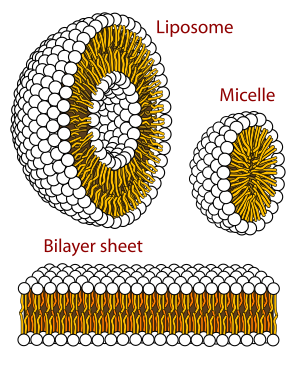Micelle facts for kids
A micelle is like a tiny, invisible ball formed by special molecules called surfactants. Imagine a surfactant molecule as having two different ends: one end loves water (it's hydrophilic), and the other end hates water (it's hydrophobic).
When these molecules are in water, their water-hating parts hide away in the middle, forming the core of the micelle. The water-loving parts stay on the outside, facing the water. This creates a tiny, round structure that helps things mix that normally wouldn't.
How Micelles Help Us
Micelles are very useful, both in our daily lives and inside our bodies. They act like tiny transporters or cleaners.
Cleaning with Micelles
One of the most common places you see micelles at work is in detergents and soaps. When you wash your hands or clothes, water alone often can't remove greasy stains or oils. This is because oil and water don't mix.
This is where micelles come in! The surfactant molecules in soap form micelles. The water-hating parts of the micelles grab onto the oil or grease. The water-loving parts stay on the outside, allowing the whole micelle (with the oil trapped inside) to mix with water and be washed away. Detergents also make water "wetter" by lowering its surface tension, which helps them clean even better.
Micelles in Your Body
Micelles are also super important for your health! After you eat, your body needs to absorb important nutrients, especially certain vitamins and fats.
Your liver makes special liquids called bile salts, which are a type of surfactant. These bile salts help form micelles in your small intestine. These tiny micelles can then pick up fat-soluble vitamins like A, D, E, and K, as well as other important fats (like lecithin). By trapping these nutrients inside, micelles make it easy for your small intestine to absorb them into your body. Without micelles, it would be much harder for your body to get these essential nutrients from your food!
Images for kids
See also
 In Spanish: Micela para niños
In Spanish: Micela para niños



